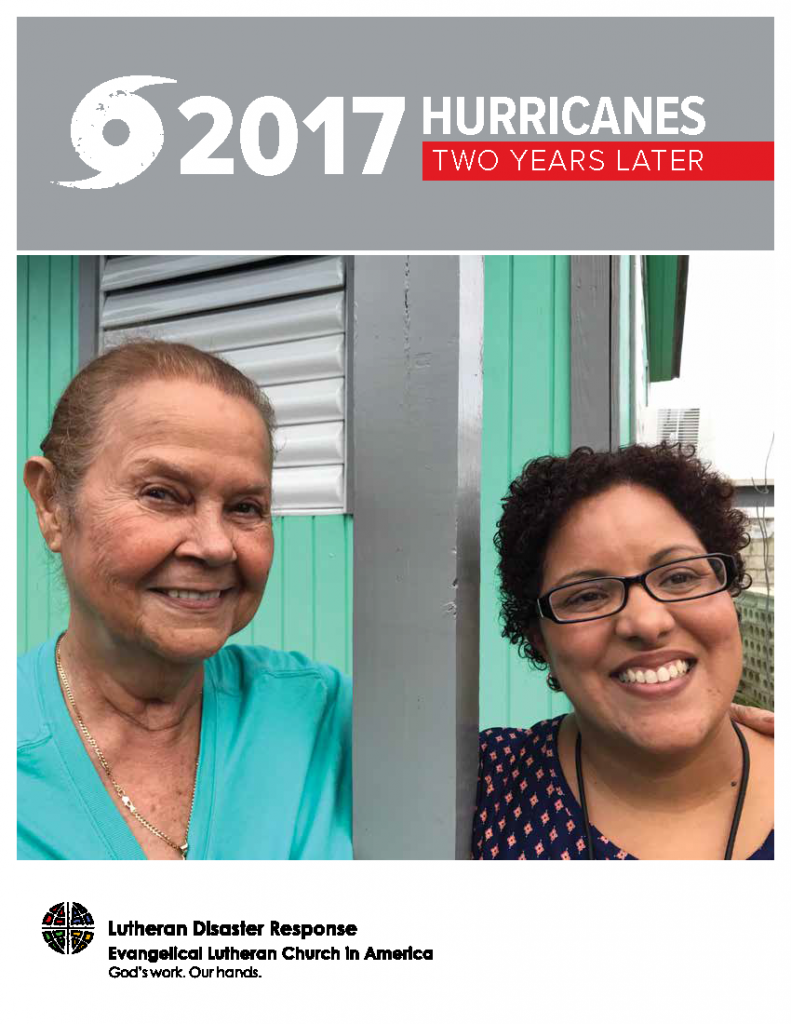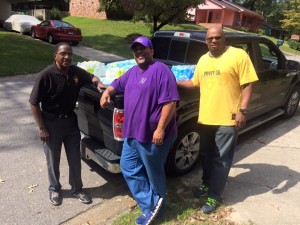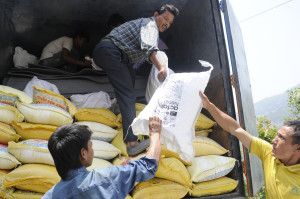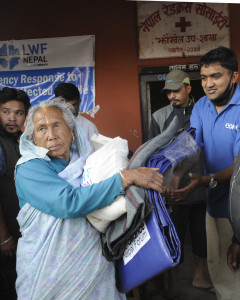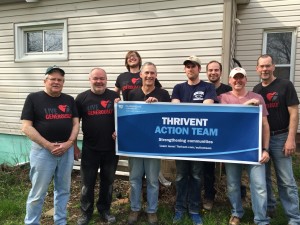The Reverend Gil Furst was the Director of Lutheran Disaster Response on 9/11. We are very grateful for his enormous contributions to our collective response to this unprecedented disaster on behalf of the church in collaboration with many partners in the years following the attack. Here is his recollection of how we witnessed God’s hope and light in the midst of destruction and darkness in the aftermath of this seminal event.
Dear friends in Christ,
Fifteen years ago, on September 11, 2001, our lives were radically changed. The World Trade Center destruction in New York and the Pentagon attack near Arlington, Virginia, are among the most significant events in our lives. The needs of those directly affected (e.g., those who lost loved ones, traumatized children, people who lost income, persons harmed or terrified), as well as those who felt the ripple effects of the tragedy, were incalculable.
The scope of the needs was unprecedented. Death totals exceeded many town populations in which our congregations are located. Over 3,000 children lost at least one parent, and tens of thousands of children lost a family member. The Lutheran Counseling Center in New York received 100 calls per day for emotional and spiritual help. Seven ELCA Synods and five LCMS Districts were directly impacted. Nine separate Lutheran social ministry organizations were part of the response. A new agency, Lutheran Disaster Response of New York, was established to focus on coordinating the New York response. As in every disaster, new needs continually arose as the recovery progressed.
The response of the Church was extraordinary. By the end of 2001 nearly $8 million came in directly to the ELCA and LCMS. The insurance fraternals, Aid Association for Lutherans and Lutheran Brotherhood, provided an estimated $10.7 million towards a coordinated Lutheran response, with each fraternal contributing $1 million of corporate funds. But the costs were equally extraordinary.
By the end of 2001 $2.7 million was granted by LDR for specific ministries in New York, New Jersey, and Washington D.C. By the end of 2002, LDR granted to the three responding areas a total of $6.8 million. By the end of 2003, LDR granted to the three areas a total of $9.5 million.
The responses in New Jersey and Washington D.C. concluded at the end of 2003. LDR-New York continued to provide services and coordinate multiple organizations to provide assistance for unmet needs until September 2008.
At the height of the New York response, over 137 separate programs were in operation. Working with the addition of interfaith funding, private organizations, even international donations, the total income for our Lutheran response neared $27 million. Long after other agencies and denominations closed their offices, LDR continued its ministries. As is usually true, the Lutherans were among the first to respond and the last to leave.
The initial components of the response included:
• counseling directly-impacted children, adults, and families
• providing for emergency needs of individuals and families
• supporting the 21,000 students in Lutheran schools (47 students lost primary care-givers in the destruction), including counseling and tuition assistance for children whose families lost their livelihood
• direct care for “Ground Zero” rescue workers
• providing case management for unmet needs of the bereaved and unemployed
• individual emergency assistance
• respite care for clergy, rostered Church leaders, and school staff
• long-term training of clergy for trauma response
• preparing “Camp New Ground” day-camp materials for children traumatized by the attacks
• preparing and distributing recovery materials
• supporting interfaith initiatives in New York, New Jersey, and Washington D.C.
• supporting Church World Service multi-denominational programs.
• advocacy for immigrant and undocumented persons
As the response continued into its second year, new components were added:
• Lutherans led in coordinating dozens of organizations to provide assistance to unmet needs
• “Project LIFE”, a case-management program, was developed to help people access available assistance
• “New Ground” day camps were offered to community children through Lutheran congregations and schools, thirty-eight camps held in New York and New Jersey in the summer of 2002
• Individual and group counseling was expanded
• caregivers were trained for their ministries and provided with respite care
• congregational “ministry teams” were trained to provide care in their communities
• case management was provided to distribute non-profit grants to the economically impacted
• care was given to clergy and school teachers providing “on the ground” ministry
• support was given directly the families of victim’s
• counseling was provided for people traumatized by the disaster
• working with undocumented workers and others who lost employment due to the disaster
IN NEW JERSEY
740 New Jersey commuters died when the World Trade Center towers were attacked and collapsed. Support was provided for leaders and individuals, unmet needs (in partnership with 128 individuals and agencies), post-traumatic stress counseling network of 15 behavioral healthcare agencies), 15 congregations provided bereavement support groups, grief support, economic assistance, disaster preparedness, and immigration support.
IN WASHINGTON D.C.
The 9/11 Pentagon attack created a loss of life, a loss of neighbors and colleagues, a loss of jobs and income. Children in Lutheran schools were also affected. One school of 200 children is located near the Pentagon. Children on the playground heard the impact of the plane, saw the fire, heard the sirens. LDR offered extensive long-term trauma counseling to them. LDR also ministered to entry-level workers, immigrants, and new citizens affected by economic issues
Special thanks must be given:
• to our national Church leaders who offered Gospel hope by their presence: the Rev. H. George Anderson (ELCA Presiding Bishop), the Rev. Gerald Kieschnick (President of The Lutheran Church-Missouri Synod), and the Rev. Mark S. Hanson (ELCA Presiding Bishop)
• to the three synod bishops and district presidents who provided incredible leadership for their affected judicatories: President David Benke (Atlantic District) and Bishop Steve Bouman (Metropolitan New York Synod); President William Klettke (New Jersey District) and Bishop E. Roy Riley (New Jersey Synod); Bishop Ted Schneider (Metropolitan Washington D.C. Synod) and President Arthur Scherer (Southeastern District)
• to the three LDR coordinators who provided creativity and passion to the Church’s efforts: the Rev. John DiMatteo (Lutheran Social Ministies of NJ), the Rev. David Pearcy (LSS of the National Capitol Area), and John Scibilia (LDR New York).
• to Elaine Richter Bryant and the Rev. Jerry Rux, who served as associate directors of LDR
September 11, 2001, raises images of dust-covered firefighters climbing stairs to rescue people from the World Trade Center towers, and exhausted emergency workers climbing huge piles of rubble searching for survivors. But there are also images of pastors and chaplains offering words of hope or consolation to stunned and shocked survivors. There are teachers calming upset students. There are congregations gathering for worship, and neighbors praying with neighbors. There are piles of letters, offers of help, and generous donations.
Where was God in all this? God was in the ashes and the dust, in the destruction and the blood, reaching out in sorrow and compassion as our hands were reaching out to help. We who are in Christ are people of hope, changed by a resurrected Lord who is always present with God’s people. Where was God? God was there – and God is still there.
From the moment the first plane struck, the Church responded as the Church. And the Church continued to respond for the long haul. We do not come empty-handed to real life situations, even to situations as terrible and global as 9/11. We, the Church, were blessed to be called to serve at such a challenging time. Through your donations, through your prayers, you were there too, along with the firefighters, the recovery workers, the chaplains, the pastors, the counselors, the families of victims.
As in all disasters, those who suffer are supported by God’s healing grace. Those who respond are God’s enfolding arms and healing hands, providing comfort and renewal by word and deed.
Gilbert B. Furst
Retired Director
Lutheran Disaster Response
